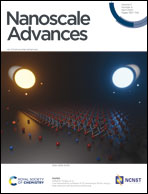Electrical transport properties and ultrafast optical nonlinearity of rGO–metal chalcogenide ensembles†
Abstract
In recent times, nanomaterials that harvest solar radiation and transform it into other forms of energy are of considerable interest. Herein, the electrical transport properties of reduced graphene oxide (rGO), rGO–zinc selenide (rGO–ZnSe) and rGO–zinc telluride (rGO–ZnTe) thin films have been investigated at 87–473 K under both dark and illumination conditions. A comparative study of photosensitivity (P) and charge carrier mobility (μ), calculated using a trap-free space charge limited current model, shows the highest values for 54 wt% ZnSe and 50 wt% ZnTe contents (namely samples C1 and C2, respectively). A decreasing trend in P values with increasing temperature is seen in all the samples (rGO, C1, and C2) and has been attributed to enhanced electron–phonon scattering. Also, photosensitivity and change in mobility under illumination show a maximum change for C2 in the entire temperature range. The nonlinear absorption coefficient (β) of C2 is ∼1.6 times higher than that of C1 and both the samples depict a positive nonlinear refractive index when measured with 630 nm femtosecond pulses. Moreover, C2 shows a two-fold faster electron transfer rate as revealed by a time resolved fluorescence study than C1. This, along with better dispersion of ZnTe nanoparticles in the rGO matrix, explains why rGO–ZnTe has better optoelectronic properties as compared to the rGO–ZnSe composite. These results in turn make the rGO–ZnTe composite a promising candidate for optoelectronic and photonic device applications.



 Please wait while we load your content...
Please wait while we load your content...